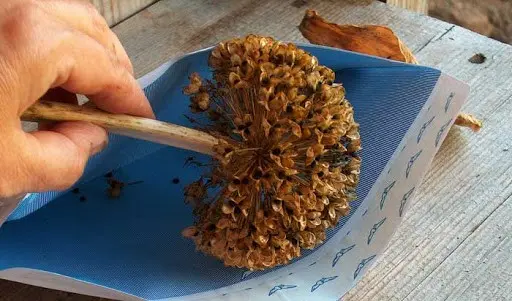Contents
Bulgarian ornamental onion is a perennial plant with elegant dark pink flowers with a white border. Differs in unpretentiousness in leaving and rather good winter hardiness. Used to decorate the garden in single plantings and flower arrangements.
Description
Bulgarian onion grows up to 90 cm in height. Flowering begins at the end of June. 20-30 small flowers of pale pink or dark red colors appear on the shoots. Flowering lasts no more than a month, but even withered flowers can be used to make floral arrangements. Allium has a satisfactory winter hardiness, but in regions with frosty winters, not only root mulching will be needed, but also burlap shelter.
Despite the fact that the bulb of the Bulgarian onion shoots only one season, it constantly forms children, so the plant is considered perennial. Thanks to its beautiful, original colors, allium can be used in almost any design.

In shape, the flowers of the decorative Bulgarian onion resemble bells.
Cultivation from seeds
Allium can be grown from seeds. They are pre-treated in Epin, Kornevin or other growth stimulants. Then planted on a previously prepared site. It needs to be cleaned, dug up and a complex mineral fertilizer with humus applied. They are deepened by 1-2 cm, and at first they make a tight fit.
Watered and covered with foil. After the sprouts appear, the Bulgarian onion is planted in a permanent place at a distance of 20-30 cm.
The next season, the mulch is removed and fed with nitrogen fertilizer.
How and when to plant outdoors
The optimal time for planting Bulgarian onions is the end of September (in the south – the end of October). If you carry out the procedure at this time, the plant will have time to take root and tolerate winter frosts well. The place is selected based on the following requirements:
- the site should be well lit (even a weak shadow is undesirable);
- the flower bed is located on a hill. In the lowlands where moisture accumulates, the allium onion will feel uncomfortable;
- where possible, landings protect from winds.
Instructions for planting Bulgarian onions are standard:
- For several weeks, the site is dug up and fertilized with mineral fertilizers and humus. You can add a few pinches of wood ash, but you can’t add nitrogen fertilizing in the fall.
- Holes for allium should be deep enough: at least 3 bulb diameters. The distance between them is 20-30 cm (depending on the desired planting density).
- If groundwater is suitable for the soil surface, it is imperative to lay a layer of drainage (small stone).
- If the soil is infertile, a mixture of humus with garden soil and wood ash is added to the hole during digging or during planting.
- The allium bulb is placed on the bottom and buried, after which it is well watered and mulched.
It is better to plant Bulgarian onions in the fall.
Care
Allium care is simple – compliance with watering standards and regular fertilization. Agrotechnics standard:
- Water is not given very often: in case of drought, weekly, but if the rains are plentiful, then additional moisture is not needed.
- So that the soil does not dry out, it is mulched with improvised materials.
- Top dressing for allium is applied 3 times per season. In the middle of spring give nitrogen fertilizer. During the formation of buds and after flowering, a mixture of superphosphates with potassium salt or Agrofoska is added (complex fertilizer can also be used).

- On the eve of winter (in mid-September), humus and peat can be put on the soil surface.
- Loosening is carried out periodically, it is advisable to do this after each watering and fertilizing. Bulgarian ornamental onions prefer light, oxygenated soil.
- The flower bed should be periodically weeded from weeds. Mulch will help get rid of them.
Diseases and pests
Allium rarely suffers from diseases, because it has good immunity. But improper agricultural practices (excess water, growing in lowlands where moisture stagnates) can lead to rot, powdery mildew and other fungal infections.
To prevent this, it is necessary to monitor the watering of Bulgarian onions (the soil should be slightly moist). When the first signs of damage appear (powdery plaque, spots on the leaves, rapid yellowing of the foliage), it is necessary to treat the allium with any fungicide: Bordeaux liquid, Ordan, Fitosporin, Tattu, Topaz.
Also, allium can be invaded by pests. Onion flies and root mites parasitize the culture.
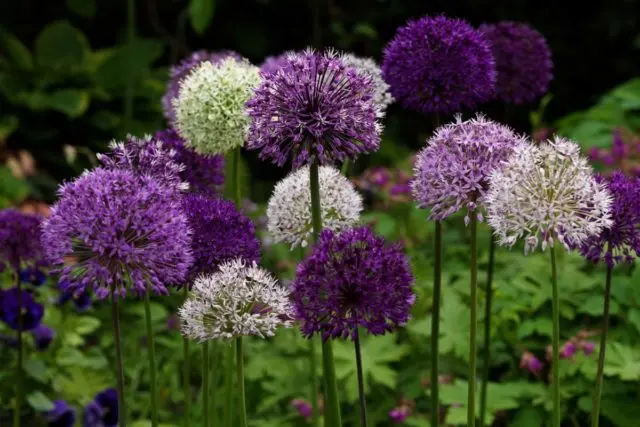
Folk remedies (ash solution, infusion of onion peel, decoction of marigold flowers) and insecticides will help to cope with insects: Aktara, Spark, Karate, Konfidor
Reproduction
Allium can be propagated by seeds and vegetatively (bulbs, dividing the bush).

When seed breeding, Bulgarian onions may not completely repeat the signs of the mother bush.
This method is laborious and not always effective: allium seeds must first be collected, planted in September in open ground under a film. After the appearance of sprouts, seedlings will need to dive.
Most often, summer residents propagate allium by dividing an adult bush (minimum age 3 years). Bulgarian onions are dug up and separated so that 2-3 healthy shoots remain on each division. Then they are planted in a permanent place at a distance of 20-30 cm.
Growing tips
Caring for an allium is not very difficult. But when growing in the country, it is useful to know about some of the features of agricultural technology. Experienced gardeners recommend paying attention to the following tips:
- For prevention, it is recommended to warm the bulbs of Bulgarian onions before planting all night at a moderate temperature of no more than 35-40 ° C. Periodically, plants need to be inspected, and at the beginning of summer – sprinkled with tobacco dust. This allows you to reliably protect the foliage from parasites.
- Bulgarian onion blooms for a short time. In addition, during the appearance of inflorescences, the lower foliage begins to fade, which spoils the decorativeness of the allium. Therefore, it is advisable to plant ground covers (ampelous plants) or undersized flowers, as well as small hostas, next to it. Then the Bulgarian bow will look more attractive.
- Since the allium blooms from late June to mid-July, after which the plant begins to form seeds, it is advisable to plant flowers next to it that bloom at this time. These are, for example, petunia, lavender, hydrangea, marigolds, verbena and many others.
- If you grow Bulgarian onions from seeds, you should keep in mind that their germination is not very high. Therefore, it is necessary to sow many grains at once, and then dive the plants – then a significant part of the allium seedlings will be preserved.
Photo in landscape design
In the garden, allium is used in single and composite plantings: on an open, well-groomed lawn, in discounts and rock gardens, along paths, next to the gazebo and other recreation areas, in multi-tiered compositions.
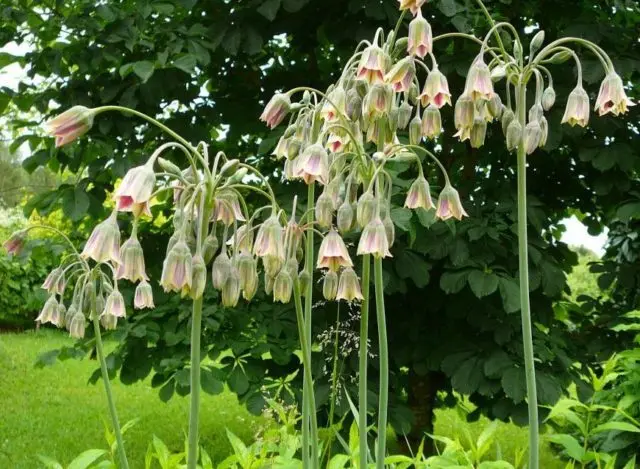
Allium looks beautiful in single plantings
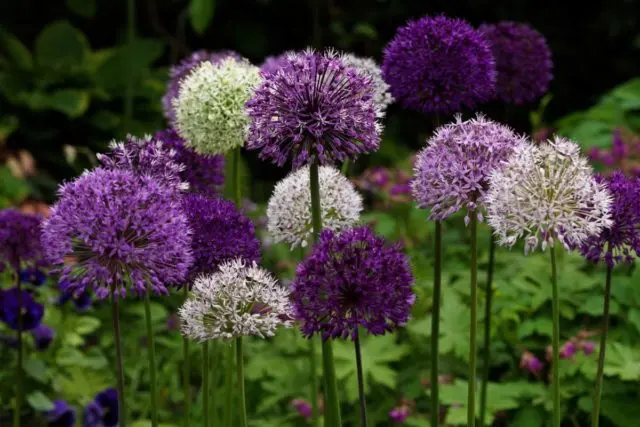
Several varieties of ornamental onions can be combined with each other
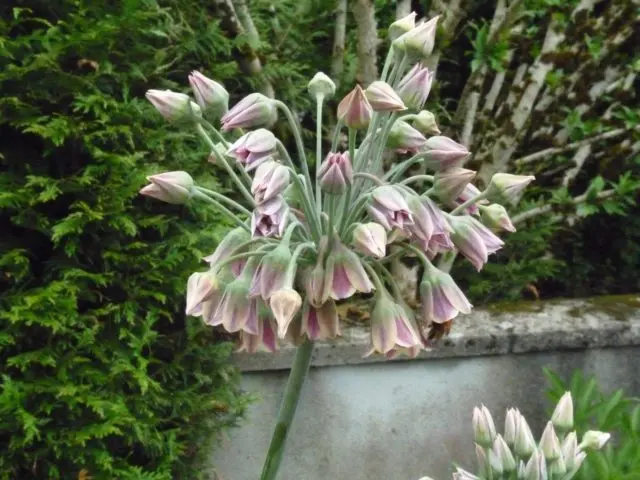
Allium effectively decorates the coast of the reservoir
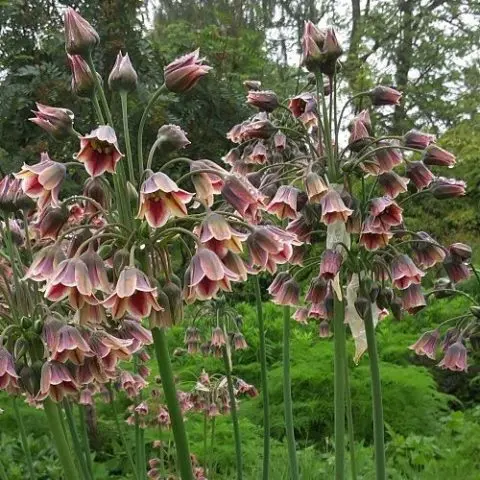
Allium will attract attention if planted against a backdrop of bright garden greenery.
Conclusion
The Bulgarian ornamental bow is interesting for graceful flowers of unusual color. It is an undemanding perennial plant grown from bulbs. Subject to standard agricultural practices, allium flowering will last at least three weeks.










